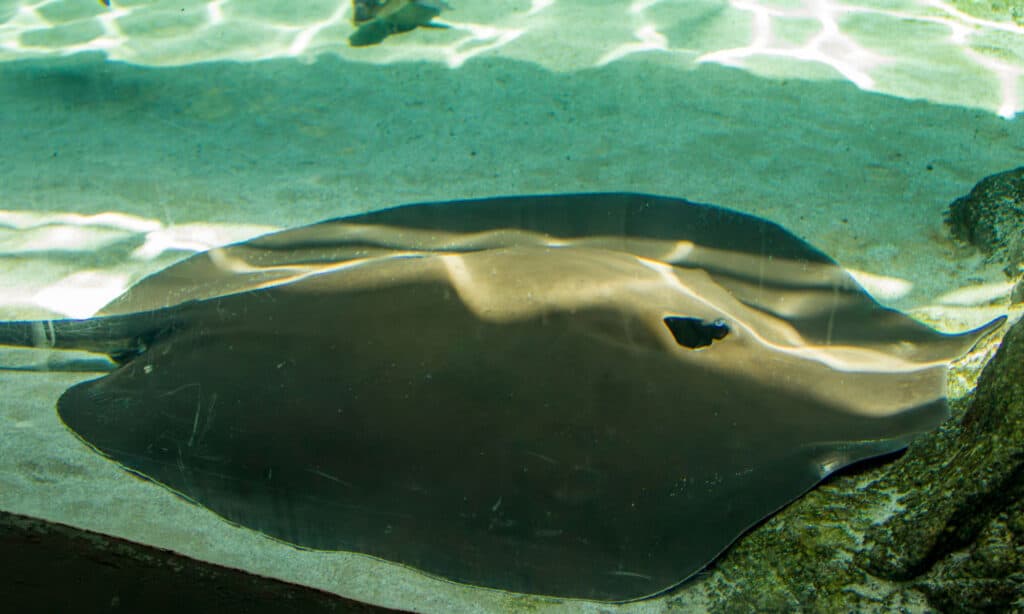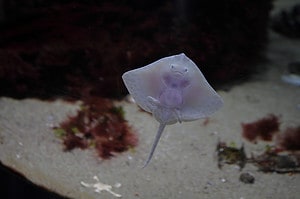Stingrays are a group of sea creatures that have captured the imagination of people for generations. Known for their flat disc-like body and long, whip-like tails, these fascinating creatures vary widely in size, coloration, and behavior, depending on the species. While some stingrays are relatively small, others can grow as large as a car or even a school bus! Of all the species, one stands out as the largest stingray in the world: the giant freshwater stingray. In this article, we take a close look at this incredible animal, learning about its size, habitat, and behavior. Whether you’re a seasoned marine enthusiast or simply curious about the mysteries of the underwater world, the giant freshwater stingray is a creature worth exploring. So, without further ado, let’s dive in and discover the largest stingray in the world!

The giant freshwater stingray is the largest stingray in the world.
©Danny Ye/Shutterstock.com
The giant freshwater stingray is the largest stingray and one of the largest freshwater fish in the world. Some individuals grow as large as a school bus. These creatures typically inhabit rivers and estuaries in Southeast Asia. They have flat, diamond-shaped bodies, which can be 7 feet in length and 14 feet in width. The giant freshwater stingray also has a long, whip-like tail up to twice the length of its body. Their mouth is lined with serrated teeth.
The Giant Freshwater Stingray: Habitat
The giant freshwater stingray, also known as the freshwater whipray (Himantura chaophraya), is found in freshwater rivers and estuaries in Southeast Asia. Its habitat ranges from the delta of the Mekong River in Cambodia to the Chao Phraya River basin in Thailand and the Malay Peninsula. This massive stingray prefers deep pools in large, slow-moving rivers with sandy or muddy bottoms and dense vegetation. These environments provide good cover for the stingray to hunt and avoid predators.
The Giant Freshwater Stingray: Behavior

The giant freshwater stingray is also known as the freshwater whipray.
©tristan tan/Shutterstock.com
The giant freshwater stingray is a relatively solitary creature. It spends most of its time hidden in the depths of rivers or estuaries. They are nocturnal and prefer to hunt at night when predators are less likely to detect them. During the day, it often buries itself in sediment or rests in shallow areas.
This large stingray can produce strong electric fields to locate prey, navigate its environment, and communicate with other stingrays. It also has the ability to “taste” its environment using electroreceptors on its skin.
As an ambush predator, the giant freshwater stingray preys on a variety of aquatic animals, including fish, crustaceans, and mollusks. It uses its long, whip-like tail to stun or immobilize prey, before crushing it with its powerful jaws.
During the breeding season, which occurs from December to February, this stingray migrates to estuaries to mate. The females give birth to live young, which remain in estuaries until they are large enough to join the adults in the deeper pools of the rivers.
Overall, the giant freshwater stingray’s behavior is fascinating and unique, reflecting its adaptations to life in freshwater river systems. However, like many freshwater species, it suffers habitat destruction and overfishing. These could impact its behavior and ecology if not properly addressed.
IUCN Status
Although the giant freshwater stingray is a formidable predator, it is also threatened by overfishing and habitat destruction. It is a vulnerable species according to the International Union for Conservation of Nature (IUCN). Habitat destruction, pollution, and overfishing threaten their habitat. Agriculture, industrialization, and dam building upstream can also significantly impact the river systems the stingray inhabits. The degradation of its habitat is one of the main reasons the giant freshwater stingray is a vulnerable species.
Despite the habitat threats, conservationists are making efforts to protect the giant freshwater stingray and its freshwater habitats. Conservation groups are working to better understand the species and its ecology. They also advocate for sustainable fishing practices and improved management of river systems. The giant freshwater stingray is an important part of the aquatic ecosystem and is well worth studying and protecting.
In Conclusion
The giant freshwater stingray is an impressive and intriguing freshwater fish. It has captured the imaginations of people all over the world. Its size, strength, and unique adaptations make it truly remarkable. However, many other fascinating details about this creature make it worth studying and protecting. Its behavior, habitat, and ecology all offer insights into the complex and interconnected nature of freshwater ecosystems. These animals show us the importance of preserving these systems for the benefit of wildlife and people alike.
Unfortunately, the giant freshwater stingray is suffering habitat loss and overfishing. They are classified as a vulnerable species by the International Union for Conservation of Nature (IUCN). It is our responsibility to recognize their value and work to protect them and their habitats before it’s too late.
Whether through sustainable fishing practices, improved management of river systems, or the creation of protected areas, there are many ways that we can help ensure the continued existence of the giant freshwater stingray. By doing so, not only will we preserve a unique and awe-inspiring creature, but we will also safeguard a vital component of the freshwater ecosystem and promote the well-being of both animals and humans alike.
Thank you for reading! Have some feedback for us? Contact the AZ Animals editorial team.








